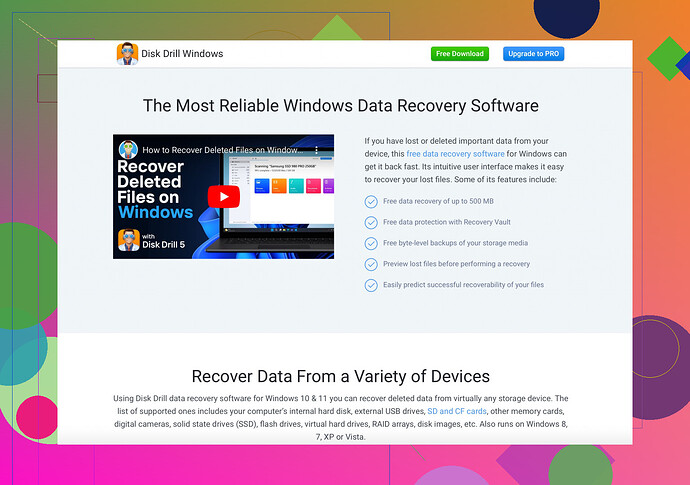My SD card suddenly became RAW and I can’t access my files. This card has important photos and documents, which I need to recover urgently. What are the best methods or software to recover data from a RAW SD card? Any help would be greatly appreciated!
Oh no, RAW SD card issues are the worst! Totally been there, so I get the panic mode you’re probably in. But don’t worry, there’s light at the end of this data recovery tunnel.
First off, why does an SD card go RAW? It usually happens due to file system corruption, bad sectors, improper removal, or even malware. The system doesn’t recognize the file system on the card, which is why it appears as RAW.
Alright, here’s what you need to do:
1. Don’t format the SD card!
- I know it prompts you to format, but don’t. Formatting will erase all the data on the card, making recovery much harder.
2. Use Data Recovery Software
- There are several good data recovery tools out there. One of the most popular is Disk Drill Data Recovery Software. This tool is user-friendly and supports RAW SD card recovery.
3. Steps to Recover with Disk Drill:
- Download and Install Disk Drill:
- Get it from the official site and install it on your computer.
- Connect Your RAW SD Card:
- Use a card reader to connect your SD card to the computer.
- Launch Disk Drill:
- Open the software and select your SD card from the list of available drives.
- Scan Your SD Card:
- Start the scan process. Disk Drill will scan for recoverable files.
- Preview and Recover:
- Once the scan completes, you’ll see a list of recoverable files. Preview them to check if they can be fully recovered. Select the files you need and hit the ‘Recover’ button.
4. Backup Your Data:
- After recovery, immediately save your files to another storage location. And make it a habit to back up your data regularly to avoid future headaches.
5. Check Card Health:
- Use tools like CHKDSK (Windows) or Disk Utility (Mac) to scan for errors. Fixing these errors can sometimes make the card usable again, but it’s always safer to buy a new one if the current one is failing.
6. Format the Card (After Recovery):
- Once you’ve got your data back, go ahead and format the SD card to a proper file system like FAT32 or exFAT. This will make the card usable again, if it’s still in good condition.
In the future, make sure to safely eject the card from devices to avoid such issues. File system corruption often happens from abrupt removal. And regularly back up those precious photos and docs!
Seriously, it’s a pain but totally salvageable!
Alright, dealing with a RAW SD card can feel like the end of the world, but it’s totally not. So, here’s my take:
You’ve already got some pretty solid advice from @suenodelbosque, but let me add a little twist. Let’s consider a few more methods to give you all the options on the table:
Data Recovery Software Options (Other than Disk Drill)
-
Recuva
- This is another popular choice for data recovery. It’s made by the same folks who created CCleaner. It’s user-friendly and supports deep scans.
-
EaseUS Data Recovery Wizard
- Super reliable and has a free version that can recover up to 2GB of data, which might be enough if you have a smaller batch of critical files.
Manual Check: Connecting to a Different System
Sometimes connecting your SD card to another system (Windows or Mac) can make a difference. The other system might recognize the file system better and could grant you access or allow recovery software to work more effectively.
Command-Line Trick (For the Brave and Nerdy)
If you’re comfortable with some command-line interface (CLI):
-
Windows: CHKDSK
- Open Command Prompt (as administrator) and type
chkdsk X: /f(replace X with your SD card drive letter). This might fix errors causing the RAW state.
- Open Command Prompt (as administrator) and type
-
Mac: Disk Utility
- Open Disk Utility, select your SD card, and click First Aid.
Note: These command-line tools can sometimes work miracles, but if the corruption is too severe, you might need to stick with software recovery.
Check Hardware Issues
Alright, here’s a curveball: sometimes, the issue is the card reader itself! If possible, try a different card reader or even a different USB port. Sounds basic, but it’s overlooked often.
Safeguard Your Data in the Future
Learning from this is crucial. Consider regular backups using cloud storage services like Google Drive, Dropbox, or an external hard drive. Always safely eject your storage devices to minimize corruption risks.
And for everyone reading, don’t skimp on data recovery methods. It’s often worth trying multiple software solutions, as different algorithms might pick up different data fragments.
Final Thought
After successful recovery, if your card keeps acting up, it might be time for a new one. Corrupted once can mean it’s more prone to future errors. Invest in reputable brands to avoid repeat incidents.
Hope this adds some fresh insight without just echoing the same steps!
And for those who haven’t tried it yet, give this link a whirl to get started with Disk Drill. It’s a lifesaver in the data recovery field.
